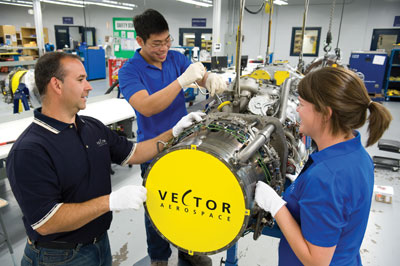
News
On Final: A competitive advantage
Aviation and aerospace are global industries and there is an increasingly global search for talent and intense global competition for aerospace manufacturing facilities.
September 10, 2012 By Robert Donald
Aviation and aerospace are global industries and there is an increasingly global search for talent and intense global competition for aerospace manufacturing facilities.
 |
|
| Industry training programs will need to keep pace with changing technologies and industry-specific skills sets. Photo: Vector Aerospace
|
Canada has a highly skilled workforce, which provides a significant competitive advantage over many other jurisdictions that are aggressively pursuing the development of their own industries. How do we ensure Canadian industry has sufficient workers with the right skills to meet current needs and the projected growth? If the Canadian industry does not have the necessary workforce, it is clear that the work will migrate to other jurisdictions Canada was the fourth largest aerospace manufacturing nation 10 years ago; today it is fifth – and the competition is only increasing.
Labour shortages and “skills shortages” are becoming increasingly acute.
The Canadian Council for Aviation & Aerospace (CCAA) was recently commissioned by Foreign Affairs and International Trade Canada – Invest in Canada Bureau (DFAIT), to determine if there are labour or skills shortages in the Canadian aerospace industry (Skilled Labour in the Canadian Aerospace Manufacturing Sector – March 2012).
When asked if there is an adequate supply of skilled labour in Canada, an overwhelming majority (77 per cent) of respondents answered that there is not. While there are labour shortages in some occupations, the overarching concern is the shortage of aerospace-specific skills. The study reported that there is a labour shortage in nine of 10 key occupations, and a skills shortage in all 10.
The aerospace program and policy review being conducted by the federal government also has a working group dedicated to “people and skills” which CCAA participated in. Together, industry, government, academia and other stakeholders formulated a series of recommendations with the objective of ensuring Canada maintains its competitive advantage in this area.
Numerous countries around the world (Mexico, China and Russia to name but three) are making massive investments to develop their own aerospace industries and attract global players. Likewise the MRO business is increasingly global.
Today, the work being sent to some of these countries requires lower skill levels and much of the high value; high-skill work is being done here in Canada. The only way to ensure this work stays here is to constantly upgrade our skill sets to ensure a flexible, efficient and effective workforce.
How do we maintain a highly skilled workforce? In 1998, the Canadian aviation maintenance industry was facing a critical shortage of skilled personnel and a lack of standards for most occupations in the sector. Price Waterhouse conducted a comprehensive human-resource study between 1998 and 1991. It was the first ever conducted for the industry. The study recommended action in four areas:
- Industry-defined standards of competency and skill (occupational standards)
- Establishing training programs and core curricula for post-secondary training organizations, which align with industry requirements, as set out in the occupational standards
- Recruiting new workers for the industry (an industry “outreach” program)
- Developing mechanisms for industry-wide resource planning These recommendations remain valid today and highlight the need for national industry standards of competency and the necessary collaboration between industry and training organizations (colleges and universities) to ensure training aligns with current industry needs.
The CCAA continues to work on both labour shortages and skills shortages in the industry. Ongoing projects include development of two new national curricula – a composites curriculum and a curriculum for training commercial pilots – and two new occupational standards (airside workers, and dangerous goods coordinator).
Forecasts indicate there will be substantial growth in the aviation and aerospace industry over the next 10 years. This growth will require a strong supply of skilled workers to support it.
Industry training programs will need to keep pace with changing technologies and industry-specific skills sets. The status quo is unlikely to meet the projected demand.
The CCAA annual Forum is being held October 3-4 in Ottawa, where industry stakeholders will continue to focus on the necessary partnerships required to maintain our skilled workforce and competitive advantage.
Robert Donald is the executive director of the Canadian Council for Aviation & Aerospace.